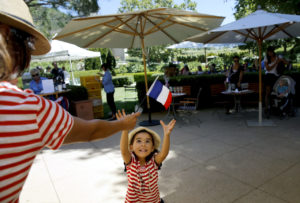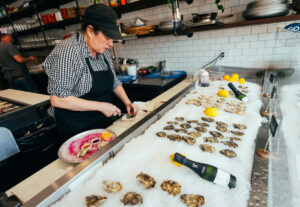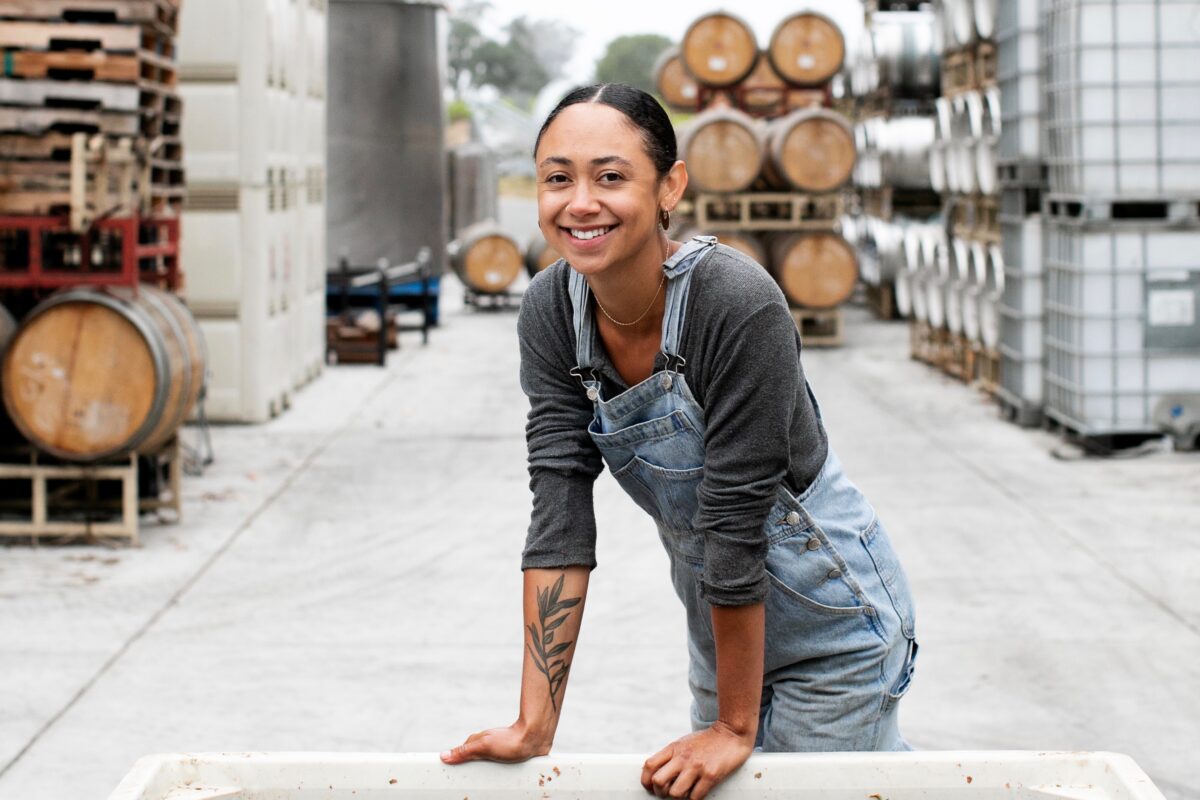The ones to watch. The up-and-comers. The fresh faces. In the coming years, these are the Sonoma winemakers you’ll say you knew way back when. In a wider industry where winemaking can at times feel snarky and competitive, the 21 folks on this list are refreshingly collaborative and supportive of each others’ work. Insiders say this is a big reason why Sonoma has launched so many notable careers, and why our county remains such a hotbed of innovation in the wine world.
We put together this list just as the many unknowns of harvest 2021 were taking shape, canvassing industry contacts, jotting down labels at wine shops, browsing rosters at custom crush operations (where many small-scale winemakers start out), and surveying the wine lists at some of our favorite restaurants. Our winners come to the industry in different ways, including small, experimental producers as well as young winemakers making waves within Sonoma’s larger corporate scene. We weren’t surprised to find out that several who made the final cut lean toward low-intervention winemaking—Sonoma remains a center of experimentation in the development of this style of wine.
Armed with this roster of stars, you’re sure to bring some of the region’s most interesting bottles to your table this holiday. Cheers!
By the team of Stacy Briscoe, Dana Rebmann, Carey Sweet and Emily Fair Weber.
Chenoa Ashton-Lewis, Ashanta Wines
Two years ago, third-generation winemaker Chenoa Ashton-Lewis discovered that her family’s organic vineyard had some unsold grapes, hanging ripe on the Sonoma Mountain property planted by her grandparents in the early 1970s. So she and her partner and co-winemaker Will Basanta picked and crushed an experimental, late-harvest Syrah-Pinot Noir co-ferment, sheltering the single barrel for eight months in a North Face tent set in the shade of her grandparents’ old cabin. The experience
was so gratifying that the next year, the couple crafted their first commercial vintage at neighboring Coturri Winery. Coturri has been making natural wines since 1964, and Ashton-Lewis and Basanta embrace the “zerozero” style, adding nothing to the grapes as they ferment: no yeast, no nutrients, no acid, no water, and no preservatives.
“We are completely enamored by the process of making wine, and watching spontaneous natural fermentation is pure magic,” says Ashton-Lewis. Now, she and Basanta fashion their art at a friend’s winery in Sebastopol, with unique blends like French Colombard fermented with wild elderberries, and a rosé of Syrah and Carignane. “Ultimately, we are guided by organic and consciously-farmed grapes, and by the native wild fruit that we’ve discovered through our backcountry hikes.” ashantawines.com
Which of your wines best salutes your work?
I’m really excited about our late-summer release, Mawu, named after the African creator and goddess of the sun and the moon. It’s a co-ferment of Merlot and Chardonnay from a vineyard at the base of Sonoma Mountain, where the soils are high in quartz from the alluvium flowing out of Dowdall Creek that runs through the property. It’s a bright, light, mineral-y, herbaceous driven red wine that you can drink with the fish and veggie-forward Cali cuisine that we mostly like to eat.
What are you drinking this holiday?
I love anything our buddy Caleb Leisure is making, but particularly his self-farmed 2019 Zeugma, his take on the classic coferment of Syrah with a touch of Viognier. He ferments the majority of his fruit in Qvevri, the large clay vessels that are an ancient Eastern European and Georgian tradition. Zeugma is a bright, alive wine with just enough voluptuousness for a cool holiday season.
Where do you like to bring guests?
It has to be a tasting with Tony Coturri, to experience true California winemaking. His rustic Coturri Winery on Sonoma Mountain should be considered an American heritage site – his Californian-Italian wines have family roots back to San Francisco coopers and to the Old World.
Jack Sporer, Fresh Wine Co.
Sonoma native Jack Sporer is laser-focused on bringing better farming and vineyard management practices to the county. Sporer owns Magnolia Wine Services, a low-intervention wine collective in the town of Sonoma. And he runs Fresh Wine Co., with the primary mission of supporting local farmers and encouraging regenerative agriculture in Sonoma Valley.
“I want to take the focus off myself and the winemaking, and put it onto the grapegrowers,” says Sporer, who highlights the name of the grower on each of his labels. Sporer acknowleges that not all growers can make a quick transition to organic methods. “But there are baby steps we can make to be a better, more regenerative farming community.”
Sporer says his winemaking is inspired by classic 1970s-era California wine. He works in a natural style, with limited extraction and only a few additives (usually just sulfur), though he says he isn’t afraid of a little new oak and higher alcohol levels. His winemaking process is straightforward, and the focus remains on the farming, the farmer, and improving the soil. fresh.wine
Which of your wines best salutes your work?
The Primitivo, my flagship wine, because it really encapsulates all of my sourcing and farming goals. Kenwood grower Ross Cannard farms without vineyard sprays for pests or disease control. It’s also low-tillage and dry farmed, which is great in a drought.
What are you drinking this holiday?
Well, I’d have to give a nod to my uncle and mentor, Will Bucklin, who makes wine at the historic Old Hill Ranch in Glen Ellen. His Ancient Grenache is a lights-out wine year after year. It comes from one of the oldest vineyards in California. It’s impeccably farmed, and it embodies the best of Grenache: fruity, leathery, and it ages well.
Where do you like to bring guests?
My favorite spots in Sonoma are Valley Bar + Bottle and Bedrock Cellars. The Ryme Cellars tasting room in Forestville is also really lovely.
Ashley Holland, Read Holland Wines
All it took was a college class called “International Beverage Education” to switch Ashley Holland’s dream of becoming an equine veterinarian to a winemaker. Holland loves horses but was fascinated by the creative essence of wines. After working at wineries across California, Oregon, Australia, New Zealand and Uruguay, she returned to Sonoma to join the Three Sticks Winery team as associate winemaker.
In 2016, Holland launched her own brand, crafting Pinot Noir, Chardonnay and Riesling, in a boutique production of just 450 cases. Her Riesling is distinctive, fermented with a touch of Muscat in a concrete egg. “Concrete makes a very complete wine, with tons of mouthfeel without any new oak character,” she explains. “It creates texture with clean, high toned aromatics, and the shape of the egg creates a a thermodynamic vortex that some producers believe concentrates celestial energy. After all, an egg is the most perfect shape in physics.” readhollandwines.com
Which of your wines best salutes your work?
The morning after we picked the 2020 Riesling, the sky was orange, from smoke. My excitement in bringing this fruit, coupled with the fear of what Mother Nature would bring next, really bent me. But there was no smoke taint. As this perfect fruit went into the press, I leaned my head on a tank and couldn’t help but cry. The wine is immaculate and unscathed by all the chaos that was happening around it.
What are you drinking this holiday?
Ernest Vineyards in Windsor has just released their Bohemian Series, showcasing single vineyards. In particular, the Chardonnay from H. Klopp vineyard in the Sebastopol Hills in the Sonoma Coast AVA is stunning.
Where do you like to bring guests?
The new Bricoleur Vineyards in Windsor is stunning, with amazing hospitality, gorgeous gardens, and nice extras like picnics.
Charlie Gilmore, Cormorant Cellars
After more than a dozen years of making wine for big, commercial labels, Charlie Gilmore set out on his own to craft the wine he wanted to make. “I like to say to myself that I’m sort of in a different career now,” says winemaker Charlie Gilmore. “It’s a totally different industry than a lot of what I’ve done in the past.”
Sourcing organic grapes from a single vineyard in Dry Creek Valley, Gilmore focused for the first three years solely on one of his favorite varietals, Sauvignon Blanc. The wine is made naturally, with minimal intervention, akin to how Gilmore feels wines were made 50 to 60 years ago.
In 2021, Gilmore found the fruit that convinced him it was time to branch out into other white varietals, including some reds: Zinfandel, Chardonnay, and Grenache Blanc. He expects to release those new whites next summer and the Zin next fall. Gilmore says he is excited to take the next steps and build on his new career. “I have hand-capsuled almost every bottle, and more importantly, I have do,ne practically every cellar task,” he says. “Making the wine with my own hands has been one of the best parts.” cormorantcellars.com
Which of your wines best salutes your work?
I only have one wine released at the moment, my SB. Sauvignon Blanc will always be important to me. I love working with growers to get the most out of the varietal in weird spots. Dry Creek should be too warm for Sauv Blanc, but I found a block on the east side of the valley that gets a little more shade in the afternoon. The extra time out of the sun protects the natural acid in the fruit. Making wines from sites that help the vines produce fruit with a robust natural acidity is essential in my winemaking.
What are you drinking this holiday?
Gros Ventre Cellars 2020 Clarksburg Chenin Blanc.
Where do you like to bring guests?
Grand Cru Custom Crush. There are close to 30 small independent wineries making various wines in differing styles at the site. Most of the wineries, including Gros Ventre Cellars, offer tastings by appointment in one of the six private tasting rooms.
Brycen Hill, Keltom Roots
Brycen Hill was a wise Virginia Tech undergrad who asked himself, “What am I going to do with this degree in chemistry?” After some soul-searching, and harvest experiences in both Virginia and France, Brycen fell in love with viticulture. This passion brought him out to western Sonoma County, where he now works as a vineyard manager and makes his own wine.
Brycen bottled his first vintage in 2019, naming his label after his parents, a portmanteau of their names, Kelly and Tom. “What I set out to make is what I like to drink,” says the winemaker, describing his wines as economical and complimentary to the seasonal, fresh foods he and his wife, a farmer in the area, enjoy eating.
Beyond drinkability, Hill is focused on sourcing from responsibly-farmed vineyards. “Usually the winemaker gets the most attention in the operation, but the winemaker’s job is just not to mess it up.”
Brycen takes a low-intervention approach in the cellar and lets his well-farmed fruit speak for itself. keltomrootswines.com
Which of your wines best salutes your work?
My 2019 Morchella Pinot Noir. I set out to make an elegant Pinot at a price point I could afford. I wanted to give the fruit the platform, so I went with a low percentage of new oak and some stem inclusion, and that gave the wine a nice structure. It’s a really pretty wine.
What are you drinking this holiday?
The Radio-Coteau Las Colinas Syrah. It’s an incredible wine at an unbeatable price, and it’s my favorite of the different Syrahs that Eric Sussman makes.
Where do you like to bring guests?
So many favorites, including Ryme Cellars in Forestville, Arista Winery in Healdsburg, Horse & Plow in Sebastopol for their very cool ciders as well as wines, Reeve Wines in Healdsburg, and Bohème, a small winery in Occidental.
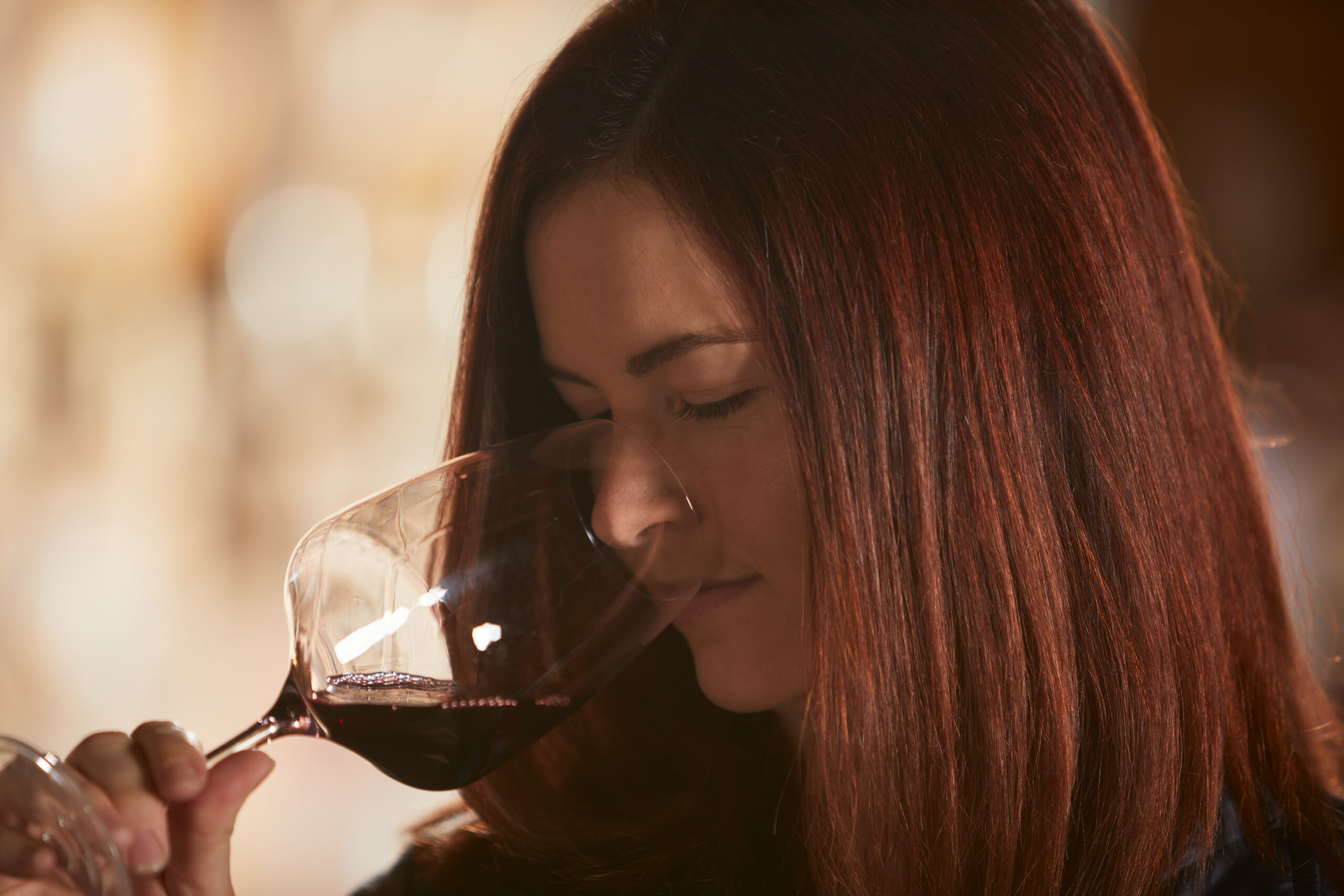
Olivia Wright, Knotty Vines, Rodney Strong Vineyards
“I’m definitely the newbie in a well-tenured team,” says Olivia Wright. She joined Rodney Strong Vineyards as an enologist in 2018 and last year took point on the company’s Knotty Vines label. “I’ve worked across the whole portfolio—all brands and labels,” she says. The experience has allowed her to work with various vineyards throughout California.
“I bring to the team not just fresh ideas but also my experience from around the state.”
Knotty Vines wines are all labeled from California and are not as focused on a specific region. “For me, the idea behind Knotty Vines are wines created for consumers who aren’t concerned with appellations.” Indeed, the lineup is a library of California classics—Chardonnay, Cabernet Sauvignon, Pinot Noir, and a red blend. Wright keeps a steady hand in the vineyards where she sources her fruit. “Harvest time, I do a lot of driving,” she laughs. knottywines.com
Which of your wines best salutes your work?
The one I have the most fun with is the red blend because I’m completely unrestrained as to what I want to use in my blends. The 2018 is Zinfandel, Malbec, and Merlot, a criminally under-rated grape. It’s meant to be approachable, fresh, and fruity.
What are you drinking this holiday?
I’m friends with crew over at Joseph Swan Vineyards. It’s nothing like what we do here. Rod Berglund has been making wine since before I was born, and he’s not remotely jaded with all that experience. Try the Trenton Estate Pinot Noir—very plush, dark fruit centric, and age-able.
Where do you like to bring guests?
My go-to spot is Ridge Vineyards in Lytton Springs. They have the whole package: beautiful spot, a great diversity of wines, and the staff is very knowledgeable.
Rosalind Reynolds, Emme Wines
Rosalind Reynolds got a crash course in winemaking after harvest-hopping for the better part of four years, working around the world, including a stop at Pax Mahle’s winery at The Barlow in Sebastopol. When she’d had enough of the international harvest grind, Reynolds reconnected with Mahle and offered to step in as his assistant winemaker in exchange for space to experiment with her own label. She bottled her first vintage of Emme Wines in 2019. “The community is strong here,” she says of working at Pax, including what she calls a “critical mass” of like-minded, low-intervention winemakers sharing space, grapes—and ideas.
Reynolds says one of her winemaking priorities is transparency. “I make a lot of zero/zero wines but I don’t want to be pegged as a zero/zero winemaker,” she says, using the term for minimal-intervention wines made with zero additions and zero adjustments.
She stresses that there shouldn’t be stigma surrounding adding sulfur or making adjustments to wines; she believes winemakers need to be up-front about their processes, so the public can learn about low-intervention styles. Reynolds works with new grapes and rotates label art with each vintage, consistently putting her own twists on classic California varietals. “I’m looking to use them in a style that’s fresher and brighter.” emmewines.com
Which of your wines best salutes your work?
I’m excited about my recently-released, first-ever Merlot, called “What Happens Next?” I sourced the grapes from an organically farmed vineyard in Santa Rosa, and from there, the fruit just made itself beautifully into wine. Pax [Mahle] confirmed it tastes like a classic California Merlot, which was precisely what I was was going for.
What are you drinking this holiday?
I love the cider from Tilted Shed in Windsor, specifically their 2020 Arkansas Black, a new single-variety cider that is as serious and attention-worthy as any local wine.
Where do you like to bring guests?
The Pax tasting room in The Barlow in Sebastopol, not only because I work there, but because it is a lovely place to hang out and drink some great wine.
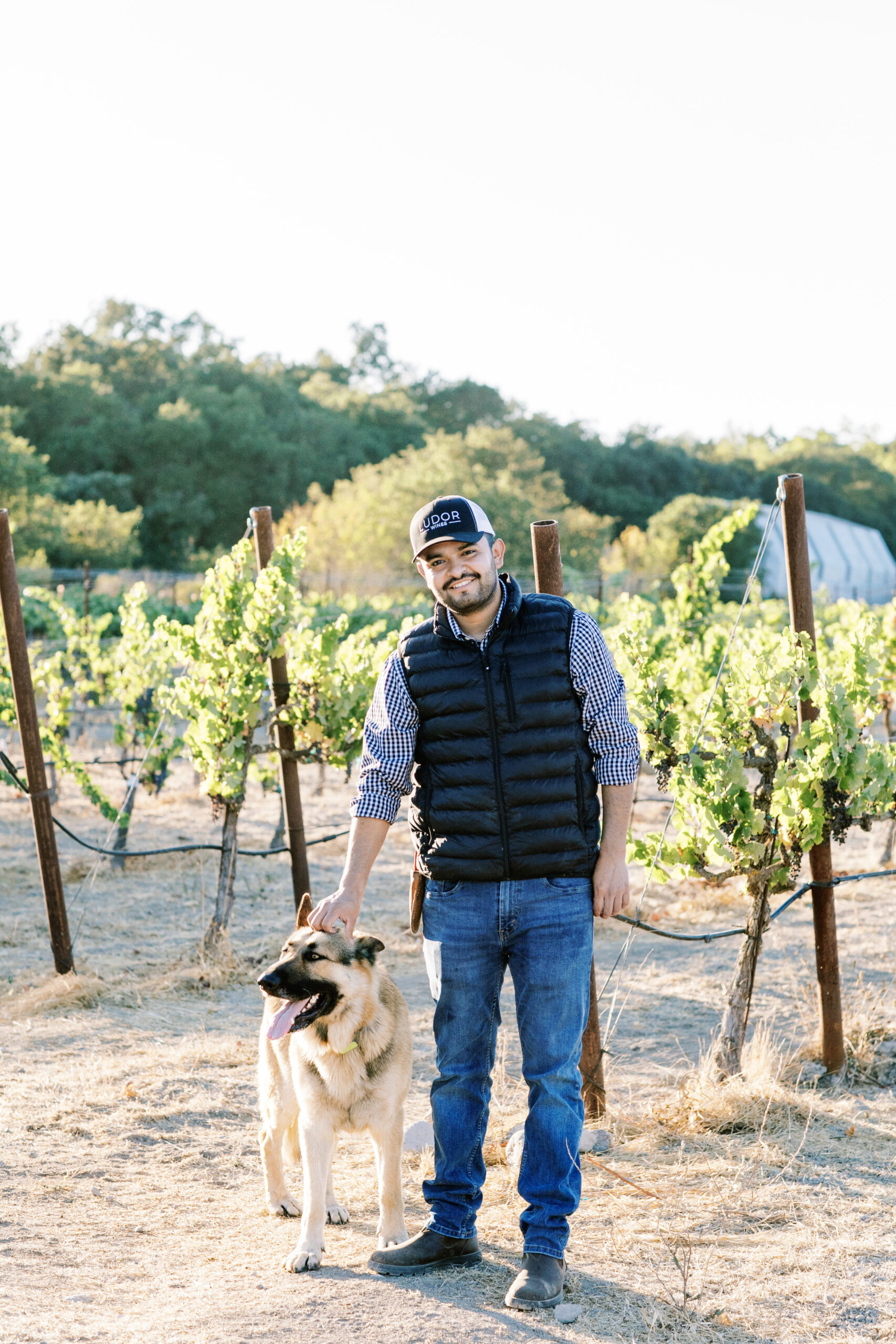
Salvador De La Cruz Jr., Ludor Wines
Salvador De La Cruz Jr. started working in vineyards at the age of nine alongside his father, an immigrant fieldworker originally from Jalisco, Mexico. “At first it wasn’t fun. I kind of hated it,” De La Cruz says. “It’s cold in the morning; the summers were hot—I never wanted to do this in my life.” If he didn’t like working the field, he should be a winemaker, his father suggested. “That planted the seed,” says De La Cruz.
As a teenager, he worked behind the scenes at B.R. Cohn Winery in Glen Ellen, and later moved into production as a cellar hand. He earned his viticulture and enology degree from the prestigious program at Cal Poly, San Luis Obispo. After graduation, he traveled to Australia to garner additional winemaking experience, but ultimately decided to come back home to the Sonoma Valley and start Ludor Wines with business partner Christian Cruz. “I felt the quality of grape growing and winemaking is higher here. People are more connected to the vineyard and the land they farm,” he says. “Ludor is all about family and friends, and keeping the connection between the vines, wines, and people—because wine, it brings us all together.” ludorwines.com
Which of your wines best salutes your work?
My Cabernet Sauvignon is from Weiler Vineyard, a vineyard my father has farmed for 22 years. It has smooth tannins, notes of fresh blackberry and black plum, and is complemented by hints of spice with a smooth caramel finish.
What are you drinking this holiday?
I really like the Sauvignon Blanc from Bernardo Muñoz, the winemaker at Jessup Cellars.
Where do you like to bring guests?
B.R. Cohn. The first things I ever learned about winemaking were from Tom Montgomery. He’s now the winemaker at Fresno State. I’m thankful for the time I spent there, and I like going back.
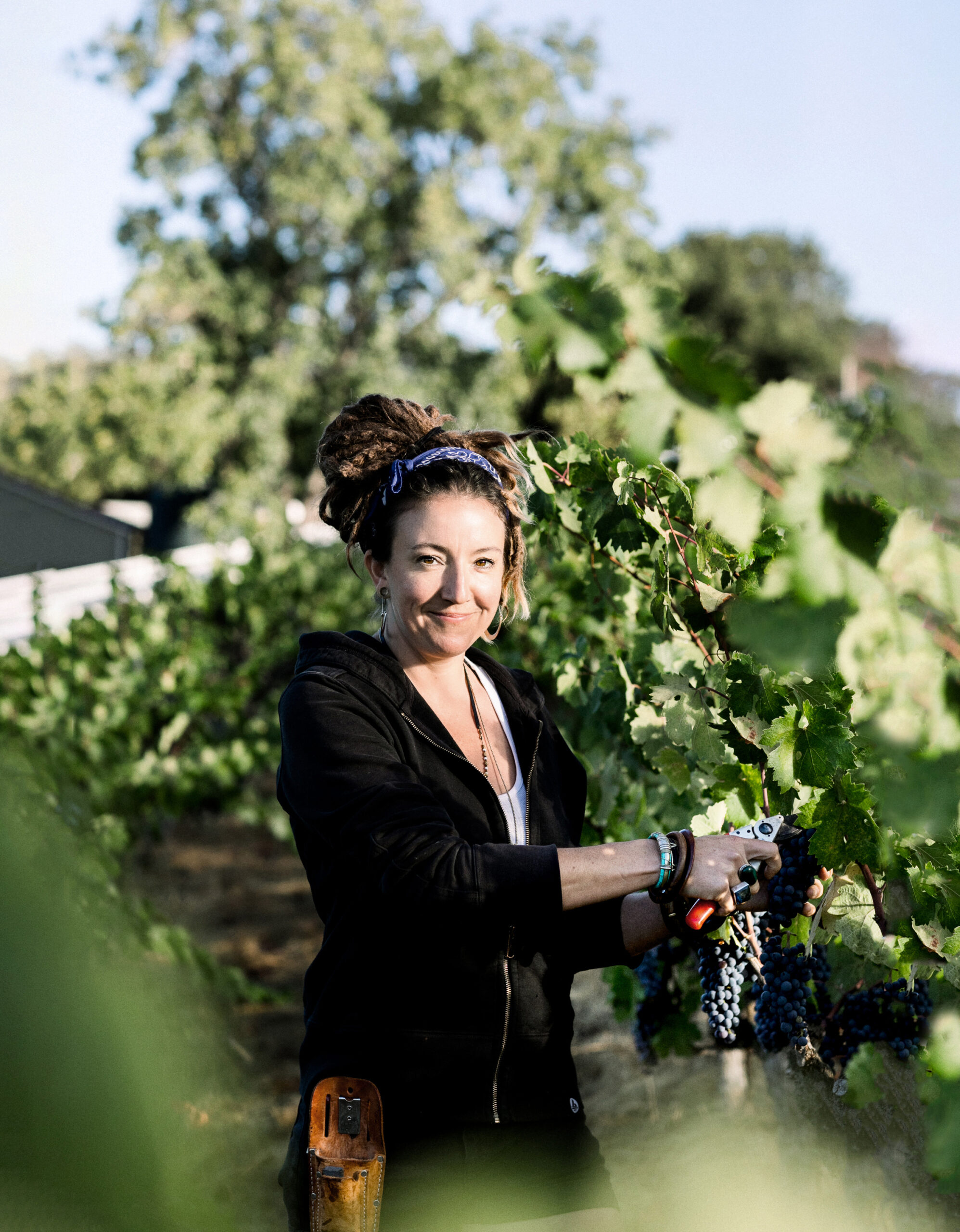
Crista Coccia, Dos Piedras Wines
A Sonoma County native, Crista Coccia founded her label last year, when the pandemic shut down her career in food and beverage. “I guess you can call it a Covid silver lining,” she says. She teamed with her wife, Lauren Cadwallader, and business partner, Jennifer Shelton, and now makes vibrant Grenache, a rosé of Pinot Noir, and Zinfandel. Yet she actually made her first wine in 2014, with a friend from Slovenia in her garage. “We brought in a bunch of Syrah grapes we farmed, borrowed some equipment and barrels, and to this day that wine is drinking great!”
The startup is boutique production of just two to five barrels per wine, and Coccia says she couldn’t have leapt in without the support of the Sonoma County winemaking community. “I am embraced by people who want me to succeed, who freely give advice, and answer my countless questions.” She and Cadwallader love to invite these friends to their Petaluma home for dinners, “storytelling and talking wine styles,” and for visits with their beloved pet tortoise, Bob. “We can all take a page out of Bob’s book of life: Go slow and have grace.” dospiedraswines.com
Which of your wines best salutes your work?
“I am learning to make the revered Rossi Ranch Grenache from my good friend and winemaker Danielle Langlois of Lasseter Family Winery in Glen Ellen. The historic Kenwood ranch is so special — at Dos Piedras, we say wine is made in the vineyard, and I touch each vine from prune to pick, then work the juice from punchdown to press.”
What are you drinking this holiday?
A shout out to my mentor, winemaker Jack Sporer of Fres.co and Magnolia Wine Services. He and co-winemaker Dan Marioni make a piquette, an awesome wine made from upcycled grape pressings. The pressings are fermented with lemon juice and the wine is capped just before fermentation finishes to give it a sparkle. The result is a wine so alive you probably want to open it over the sink.
Where do you like to bring guests?
Three Fat Guys in Sonoma. Silly name, but the wines are dead serious. They completely break the mold of the stuffy tasting room with pedantic staff. The whole vibe is feeling like you’re drinking amazing wine in your own backyard. They even have porrons [glass bottles with pointed spouts that shoot out a stream of wine] to pass around if you want to shoot some Sonoma Coast Chardonnay.

Hélène Seillan, Vérité
At 34 years old, Hélène Seillan already has 16 vintages under her belt. She also had a remarkable childhood as the daughter of Pierre Seillan, a renowned sixth-generation French winemaker who has guided Jackson Family Wines’ top-tier Vérité label since the inaugural 1998 vintage. “Wine has always part of my family and life,” she says. “My greatgrandmother taught my father how to prune vines, and now he’s on his 54th vintage. So when I was little in Bordeaux, my father was working with seven estates, and I played around the wineries and went to all the fun harvest parties.”
Seillan started working with her father in France in 2006, and, two years later, joined Vérité full time in the cellar and vineyards, which span 50 distinctive “micro-crus” across four appellations. By 2012, she was named assistant winemaker, and still works side-by-side with her father. “Coming from France, I love that Sonoma County has so many European influences in how we approach food and wine,” Hélène says. “But the freedom to be able to blend multiple appellations and enjoy different styles is huge, too. You can’t do that in Bordeaux.” veritewines.com
Which of your wines best salutes your work?
I’m very proud of my 2013 vintage. It was the first I blended 100% on my own. My father surprised me – he said, ‘I’m leaving for France, and when I get back in two months, I want all the wines done.’ He only changed maybe 2% of my Le Désir blend – he had to feel in control of something, right? His got 99 points (from Robert Parker’s Wine Advocate), and my two got 100. We joke about that all the time.
What are you drinking this holiday?
My go-to is Stonestreet Upper Barn Vineyard Chardonnay (Alexander Valley). The wine has lots of body, but it’s not overdone, so it’s really good with food. Winemaker Graham Weerts was my dad’s intern in South Africa a long time ago, and there’s lots of history there.
Where do you like to bring guests?
Skipstone in Geyserville. It’s a beautiful mountain property with high-end wines. And their winemaking consultant, Philippe Melka, is French, so we have an extra connection.
Anthony Viloria, A. Viloria Winery
When Anthony Viloria launched his business six years ago, it was a natural evolution for someone who had been in the restaurant industry since he was a teenager. Still, he was cautious, and kept his day job. Viloria has worked for 17 years with the Stark restaurant group and remains general manager and wine buyer at Stark’s Steak & Seafood in Santa Rosa. “Wine costs a great deal of money to produce,” he says. “So taking out large loans on a new venture, as well as adding time and energy beyond my full-time job, was exciting, but slightly overwhelming.”
Viloria also works with Black Knight Vineyards in Bennett Valley, crafting their Pinot Noir and making his own wines there, producing about produce 75 to 150 cases each of Cabernet Sauvignon, Petite Sirah, Grenache, Chardonnay, and Syrah. He does have some help, though – his children, Melina, 7, and Max, 5, love harvest time. “Their favorite activities are vineyard walks, sampling grapes, and watching punchdowns.” aviloriawinery.com
Which of your wines best salutes your work?
My 2017 Peaceland Vineyard Red from the Fountaingrove District is a great example of my more fruit-forward style. The grapes are actually all Cabernet Sauvignon, but it was bottled as a red so that future vintages can include a blend. Peaceland produces outstanding, vibrant fruit while maintaining wonderful acidity.
What are you drinking this holiday?
I enjoy Pop Top Productions Pet-Nat sparklers made at Black Knight – the Chardonnay is the most complex. It’s riddled and disgorged all by hand, using equipment that Pop Top owner Jason Parisi fashioned himself.
Where do you like to bring guests?
To highlight old plantings, diverse wines and biodynamic farming, I like Porter Creek Vineyards in Healdsburg. The tasting cottage is surrounded by vines, and there’s a fun chicken coop.
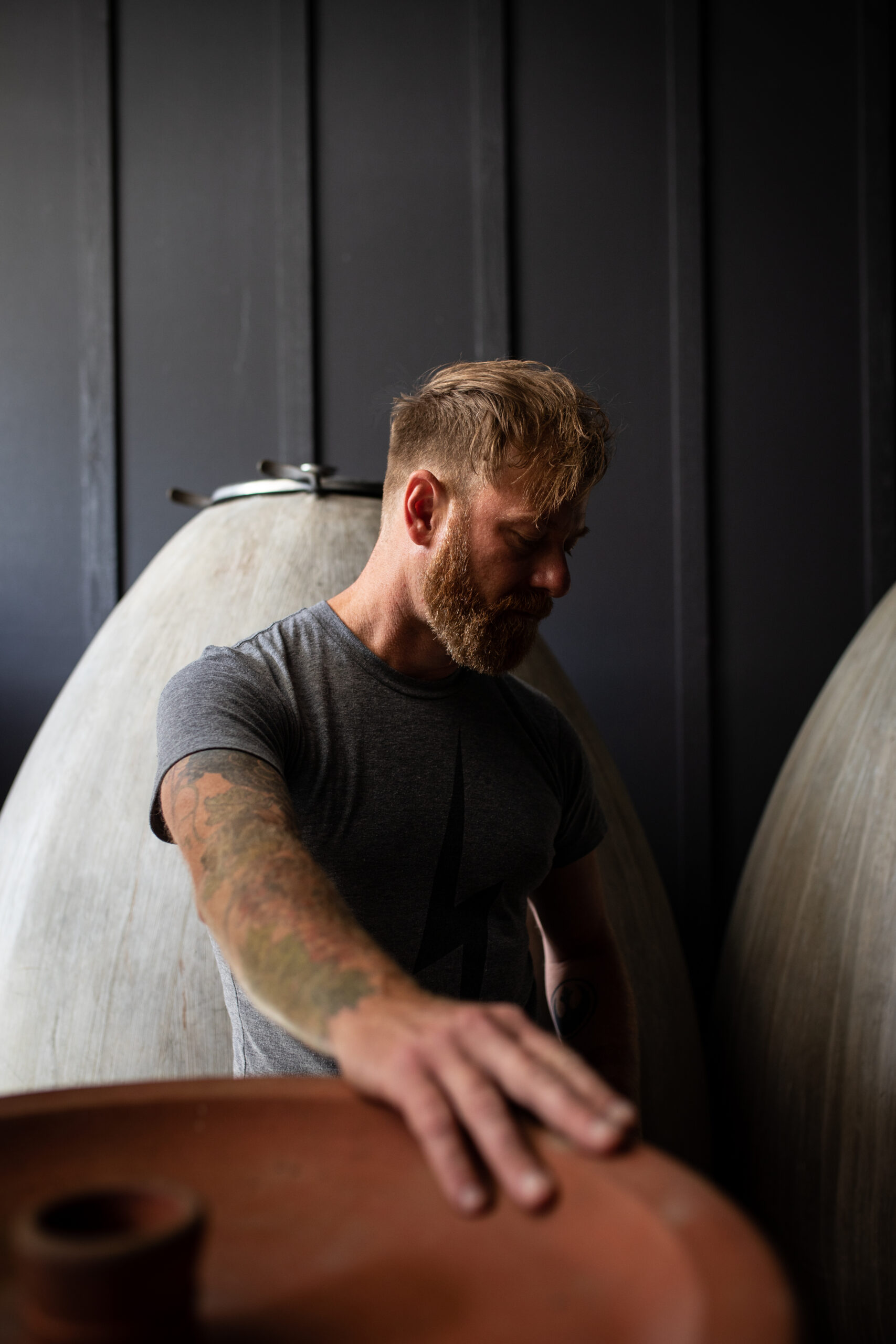
Jason Ruppert, Ardure Wines
“I essentially make wines that I like to drink,” says Jason Ruppert, the one-person show behind Ardure Wines. Enthralled by the stories he’d hear from vintners, seven years ago the then-sommelier signed up to work his first harvest, and did a deep dive into learning about regenerative farming. Earlier this year, Ruppert released both his 2018 and 2019 vintages and sold out in a matter of months.
Passionate about what he does (“ardure” means the “heat of passion” in French), Ruppert believes in purity and in lowintervention winemaking. His regenerative farming methods include rigorous cover cropping and attention to lunar cycles. And he takes an unheard-of holistic approach by adding crystals to his wines during the primary fermentation — think rose quartz, labradorite, fluorite, and shungite. “I really feel like the energetic value of each stone comes through in the wine,” says Ruppert. “We’re in modern times, so I want to create a modern wine.” ardurewines.com
Which of your wines best salutes your work?
I think the 2020 Zinfandel represents my best work yet. It’s from the Beveridge Vineyard that I regeneratively farm in Dry Creek Valley. It’s not a rosé or a still red for that matter but somewhere in between, and it tastes like a watermelon Jolly Rancher with a squeeze of salted lime.
What are you drinking this holiday?
Fuego by Jack Sporer’s label Fresh Wine Co. I don’t normally gravitate toward Sauvignon Blanc as a go-to wine, but Jack ferments his on the skins, which enhances the textural value and accentuates the phenolics in a high-toned, direct way. Drink with chips and guacamole ASAP, as it also has a hint of serrano pepper that lingers on the palate.
Where do you like to bring guests?
The tasting room at The Drink in Healdsburg is home to Rootdown Wine Cellars, Es Okay, Cole Ranch, and Leo Steen Wines. It’s a really fun, well-designed spot with other tasting rooms like Hirsch Vineyards wines within the same location.
Dan Marioni, Marioni Wine
Dan Marioni is a fourth-generation Sonoma County native making zero/zero wine (wine with nothing added and nothing taken away) under a new label, Marioni Wine. Marioni was living in the city when the 2017 fires hit— the events of that fall prompted him to move back home and support the community. He developed a deep love of natural wines while away from Sonoma, and eagerly dove into a winemaking career at Coturri Winery in Glen Ellen, working harvests and eventually partnering with Nic Coturri, Tony Coturri’s son, to head up Sonoma Mtn Winery. In 2020, Dan struck out on his own, bottling his first solo vintage and moving his operation to Magnolia Wine Services in Sonoma. “Others would probably describe my winemaking style as dogmatic, but I’m just honoring the way I learned to make wine,” he says.
Marioni believes winemakers play an important role in protecting threatened vineyard space and maintaining the vitality of Sonoma’s soils. He would like to prove that unadulterated Sonoma wines, made naturally with well-farmed fruit and zero additions, can taste great, express Sonoma terroir, and age well. He is eager to help put Sonoma on the map as a unique destination for well-made wine and holistic farming practices — “not just another Napa wannabe.” marioniwine.com
Which of your wines best salutes your work?
The 2020 Rademacher Rosé, a single-vineyard rosé of Cabernet, which came about as the result of needing to think creatively in a year affected by fires. We picked the fruit early, when smoke first started to settle into the valley, and decided to make a rosé, experimenting with a new technique to help the native fermentation kick off, and I loved the results.
What are you drinking this holiday?
Gail Wines’ Merlot. Winemaker Dan O’Brien works in a minimal-intervention style with quality fruit to make a well-balanced, drinkable Merlot. It’s a wine that I aspire to.
Where do you like to bring guests?
Valley Bar + Bottle for their stellar wine list and Buena Vista Winery for the views, the history, and the classic Sonoma experience.
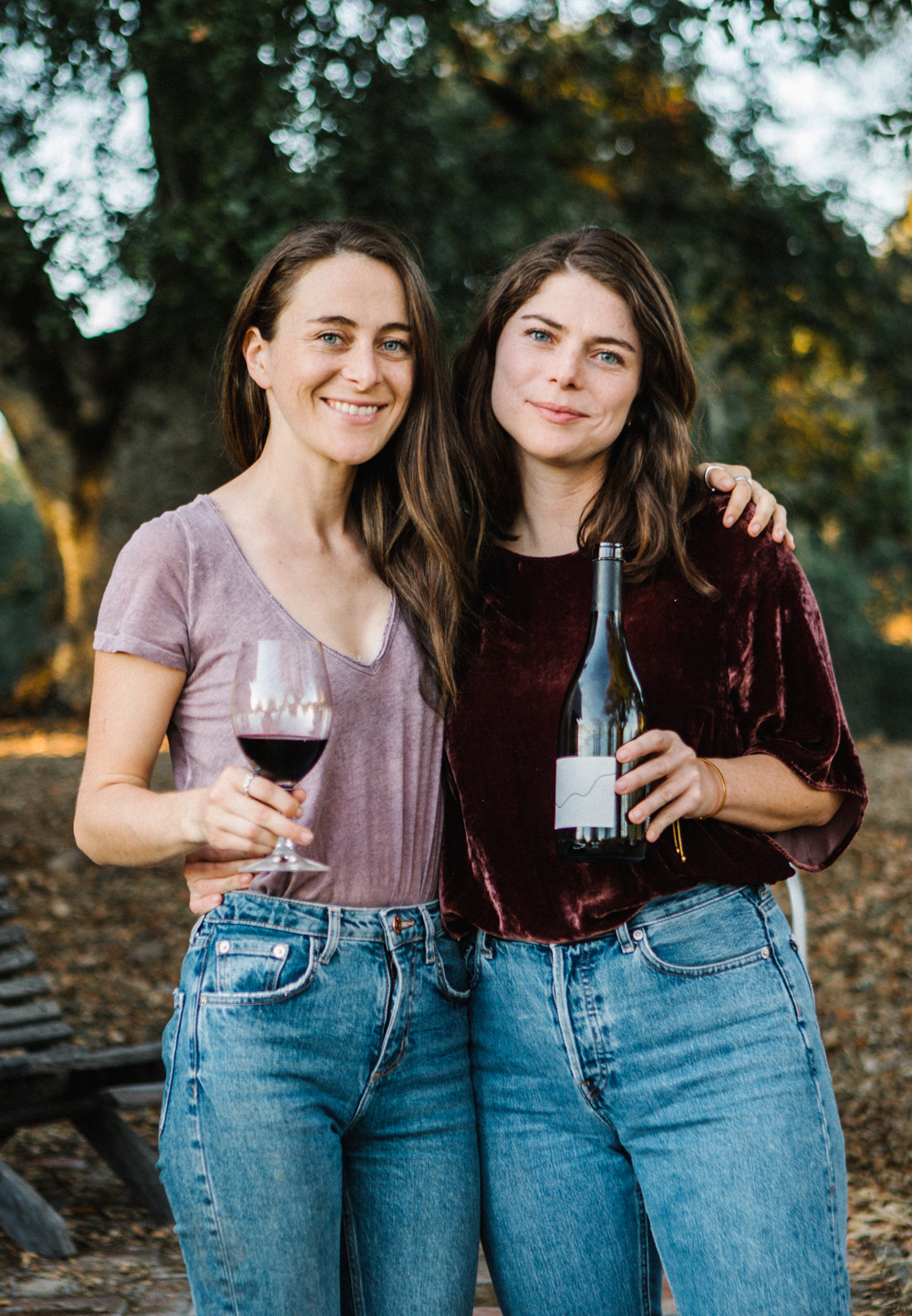
Megan and Hilary Cline, Gust Wines
Sisters Megan and Hilary Cline, two of the daughters of Fred and Nancy Cline, founders of Cline Family Cellars, started their next-generation label, Gust Wines, in 2017. The goal: making “the best wine possible” from the Petaluma Gap. “Owing to a mixture of foresight and luck, our father planted vineyards in the Petaluma Gap in the 1990s, before the area gained grape-growing renown, so we have access to what we believe to be some of the best vineyard sites,” they explain. The name Gust is a nod to the wind that defines the area. The sisters say they’re inspired by their father’s innovation and drive. “Surely, we’re putting our stamp on the family story … it’s a way we can continue his legacy, which is so important to us.” gustwines.com
Which of your wines best salutes your work?
Our 2018 Petaluma Gap Syrah is such a wonderful representation of not only Gust, but of cool climate Syrah from California. Petaluma Gap’s daily fog creates a longer growing season, which allows depth of flavor in the fruit to develop over time.
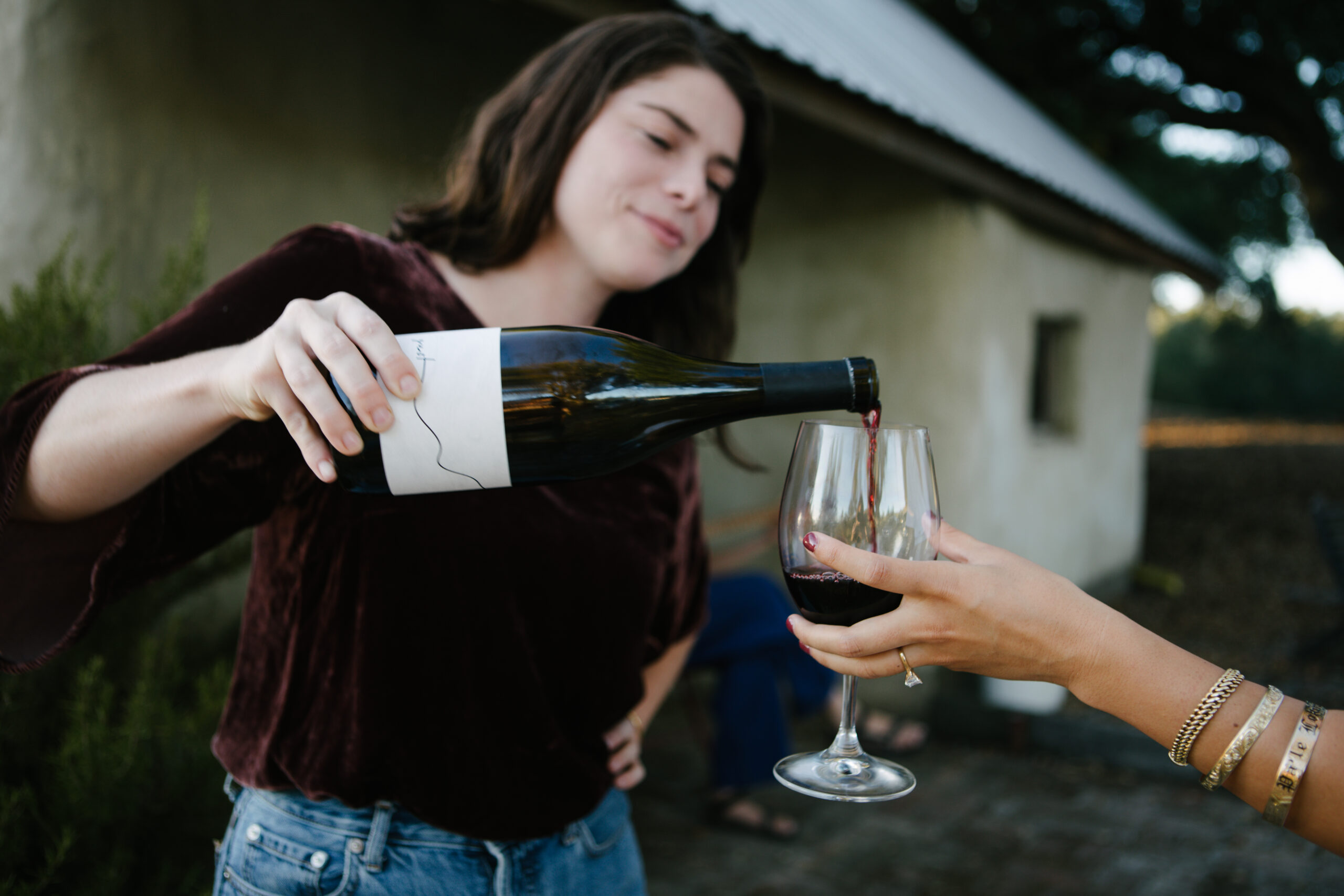
What are you drinking this holiday?
We love Ana Keller, and everything Keller is doing … we love their Rotie, which is another amazing cool climate Syrah. Erica Stancliff is a total badass winemaker as well, making some amazing wines for Pfendler and for her family’s Trombetta Wines. Kerith Overstreet, with her brand Bruliam, is another amazing producer from the region. We can’t choose!
Where do you like to bring guests?
Our ideal day in wine country would probably start off at Iron Horse. We love a good sparkling, and you truly can’t go wrong with some Wedding Cuvée. Hanzell Vineyards and Littorai Wines are both amazing experiences where you can see the entire grape growing and winemaking process. We also love bringing people to The Barlow. It’s such a fun place to taste some wine, and grab some lunch, maybe end the day with a cocktail at Fern Bar.
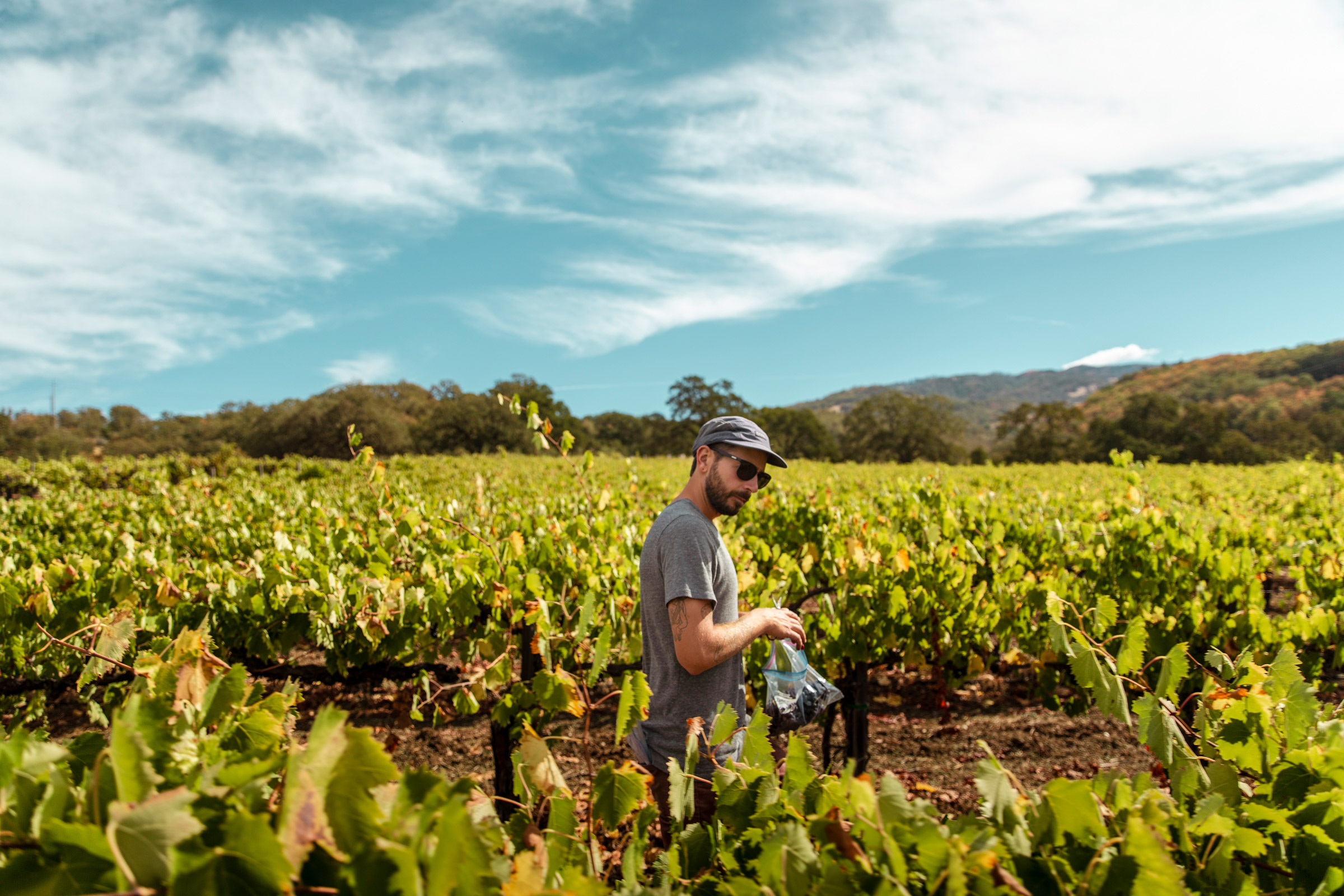
Evan Lewandowski, Ruth Lewandowski Wines
Evan Lewandowski admits he “seemingly came out of nowhere.” He started his winery back in 2012—in Utah. “It’s a weird spiritual home for me,” he says, adding, “There’s no real wine industry in Utah.” As he sources most grapes from northern California, moving to Sonoma was a natural progression. “It’s benefited my life and the wines,” he says. “The Utah dream’s not dead though.” Just deferred.
His winery name comes from the Bible. “The book of Ruth encompasses the redemption of death and tragedy… that the end has to happen so other things can begin. To me, that’s farming—the regeneration of soils, our hearts, our relationships with one another.” A true natural winemaker, Lewandowski believes good wines starts with conscientious work in the vineyard. at the winery, nothing is added, and all wines of his wines are bottled unfiltered. The portfolio of wines he makes is guided by Lewandowski’s sense of exploration and commitment to sustainability. “It’s compelling, intriguing varieties that can maintain balance and freshness in the climate they’re grown. I’ve amassed super wellfarmed vineyards that make awesome fruit. That’s my jam.” ruthlewandowskiwines.com
Which of your wines best salutes your work?
Feints, a co-fermentation of Dolcetto, Barbera, Nebbiolo, Arneis, and a hair of Montepulciano. It’s a light, perfectly chill-able red. It gives you all the things you like about a red: tannin, structure, red fruits. But it also has high acid; is snappy and fresh. I make it in a style that I can release in spring when it’s fresh, and I like it young. But I went through a vertical back to 2013 and was astonished at how it ages.
What are you drinking this holiday?
Les Lunes and Populis—the wines are incredible. The owners are involved in vineyards in Carneros and do the contract farming themselves. Their work is really to be mentioned as very honorable. The Cab-Merlot blend from that Carneros vineyard is a stunner and super surprising.
Where do you like to bring guests?
Preston Farm and Winery—they’re on the natural wine spectrum. And Dry Creek is one of my favorite AVAs in California—it’s so beautiful and picturesque.
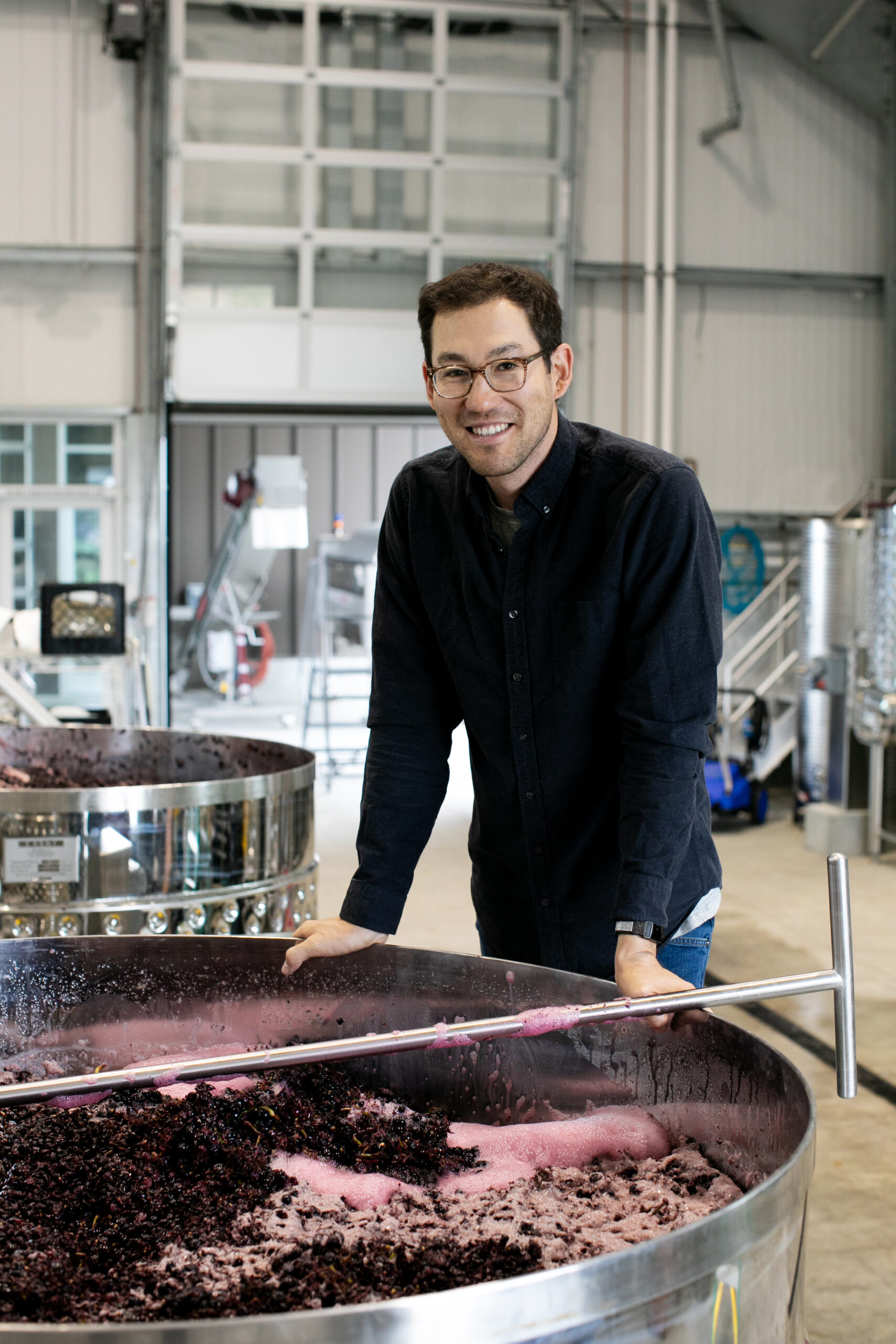
Max Reichwage, Reichwage Winery
Max Reichwage farms predominantly Pinot Noir and Zinfandel on his two west county vineyards, but being the curious type, he’s not afraid to try things out. “I think we’ve kind of found some success in having some things that are a little different,” he says. There’s the Gamay Noir from his Twin Hills vineyard, a rare varietal for Sebastopol that’s made whole-cluster, and the Carignane from Mancini Ranch, another unique variety you won’t find much of in Russian River Valley. “It looks intimidating in the glass, but when you drink it, it’s actually very, you know, gluggable and easy drinking,” says Reichwage.
Reichwage’s repertoire isn’t limited to wine. When he purchased the last parcel of Twin Hill Ranch in 2014, it included three acres of the Hurst family’s original apple orchard. After years of experimenting, in 2020 Twin Hills Cider, made with a blend of heirloom apples unique to western Sonoma County, had its debut. reichwage.com
Which of your wines best salutes your work?
The 2018 Mancini Ranch Carignane is one of my favorites; it’s a rare varietal in Russian River Valley. The vines were planted in 1922, and we have been rejuvenating the vineyard and buildings over the past six years.
What are you drinking this holiday?
I am excited to try the 2019 Dehlinger Winery Cabernet Sauvignon. It’s one of the few Cabernet vineyards in Russian River Valley. It’s an impeccably-crafted wine that ages well.
Where do you like to bring guests?
My favorite winery to bring out-of-town guests to is Ridge Vineyards in Healdsburg. They do a great job preserving old vineyards and making great Zinfandel and fieldblend wines.
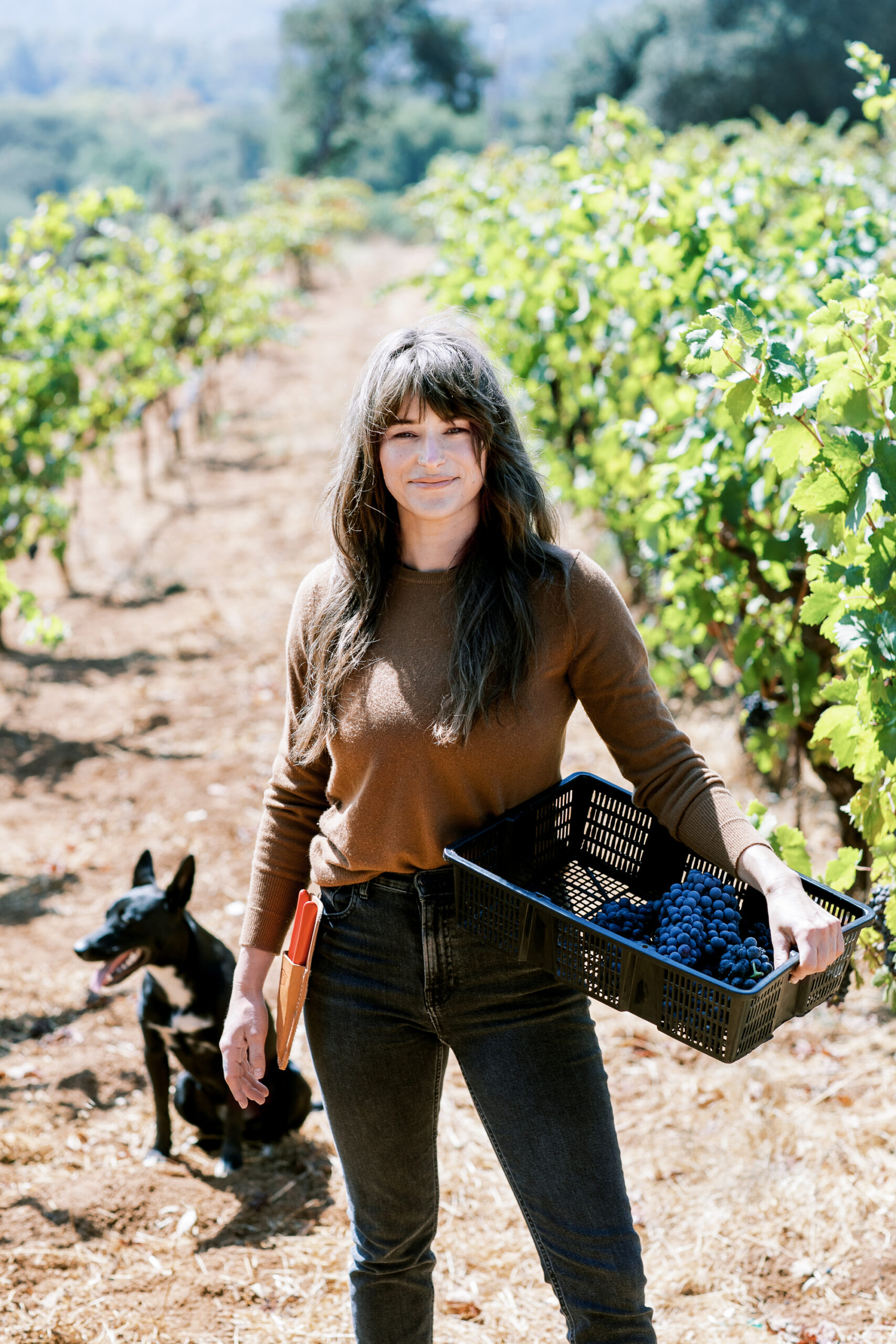
Sara Morgenstern, Killer Quail and Little Trouble Wine Co.
Sara Morgenstern still gets emails about Killer Quail wine. She never imagined something that was supposed to be a small, one-time project back in 2019 would become such a hit. When the many challenges of 2020 ruled out another vintage, she and pal Jennifer Reichardt of Raft Wines turned challenge into opportunity, joining forces to create Little Trouble Wine Co. Reichardt, an experienced winemaker and one of Wine Enthusiast’s 40 under 40 in 2019, is like a winemaking mentor, business partner, and best friend all rolled into one, explains Morgenstern. Her other best friend? Winery pup Ham, a rescue who loves romping around in the field.
“We’ve spent a lot of time finding vineyards that we truly love,” says Morgenstern. “We don’t work with any vineyards that we wouldn’t want to go have a picnic at.” One of many things on tap in the future for the women at Little Trouble: making the most of their team approach, and further experiments with unusual clones and other off-the-beaten-path offerings. “I’m very passionate about making piquette. As someone who cannot handle a lot of booze, those lower-alcohol wines are very important to me,” laughs Morgenstern. littletroublewines.com
Which of your wines best salutes your work?
The Little Trouble Grist Vineyard Sauvignon Blanc. This fruit is so special—from a teeny-tiny parcel of a 100% musqué clone high up on Bradford Mountain in Dry Creek Valley. It smells and tastes fantastic—a very bright and crunchy expression of the variety. I was never Sauvignon Blanc’s numberone fan, but Jen pushed for us to work with it, and I’m so glad we pulled the trigger. It will be available in the spring of 2022.
What are you drinking this holiday?
Emme Wines’ Merlot from Nakai Vineyard off of Fulton Road in Santa Rosa. Since my family and myself all have varying tastes, it’s nice to find something with farming and production methods I love and a flavor profile that appeals to everyone. A perfect choice for holiday food pairings.
Where do you like to bring guests?
Ryme Cellars in Forestville. Not only are the wines stunning, but the space is incredibly inviting. It epitomizes California casual. The owners and staff make everyone feel like family within minutes and that’s likely because of its’ incredibly homey feel. And it’s pet-friendly!
Lindsey Oties, Lotis Wines
Winemaking is personal for Lindsey Otis. Growing up in Santa Cruz, Otis was obsessed with grape vines and fermentation (she aged Martinelli’s in her closet as a child) and studied wine at UC Davis. After college, Lindsey harvest-hopped, chasing the seasons and gaining a vast store of knowledge along the way. Back stateside, Otis worked for Williams Selyem and Big Basin Vineyards before striking out on her own. After securing some Vermentino fruit from a coveted vineyard in the Carneros region, along with production space in Sebastopol, Otis was able to bottle her first vintage in 2019.
“I find winemaking to be all about personal expression. I view it as an art project, an extension of myself,” she says. Otis likes to work with meticulously-cared-for fruit, vineyard sites with unique geology, and varietals that are less commonly seen in Sonoma County. Due to the small scale of her operation, Otis can work in a low-intervention style and take a hands-on approach. “This project is special. I can put a lot of love into it,” she says. lotiswines.com
Which of your wines best salutes your work?
My flagship Vermentino from the Las Brisas Vineyard. The young Tablas Creek fruit budded right as I was starting LOTIS, and it was a big part of why I launched the label. The vines and my wine label have grown up, symbiotically, since then.
What are you drinking this holiday?
Read Holland’s Peter Martin Ray Chardonnay, made in Santa Rosa from grapes grown in the Santa Cruz Mountains, as well as Jolie-Laide’s Barsotti Vineyard Gamay. These two wines speak to my love of purity. They are the ultimate expressions of beautiful, intentionally-farmed vineyard sites.
Where do you like to bring guests?
The tasting space at Santa Rosa wine shop Miracle Plum. They do such a great job featuring small, off-the-beaten-path wine producers.
Abby Watt, Medlock Ames Winery
When Ames Morison, founding winemaker at Medlock Ames, recently stepped down to focus on the winery’s sustainability goals, he passed the reins to New Zealand native Abby Watt. Watt joined the winery just a year ago after previous roles at prestigious Sonoma labels, including Peay Vineyards and Kosta Browne. “I have learned to be adaptable and ride the wave of winemaking,” says Watt. “That is crucial with the differences we are seeing in vintages and the issues we need to face head-on today, with climate change and natural disasters.”
Watt is especially determined to make this year’s vintage a notable one. Not only is it the first year she has autonomy over the cellar and in the vineyard at Medlock Ames, it’s also her first year with a young family of her own. (Her first child, a daughter, arrived in the fall.) “I hope to be drinking the wines I made in 2021 with her 21 years down the road,” says Watt. medlockames.com
Which of your wines best salutes your work?
The 2020 Burning Delight, our barrel-aged Sauvignon Blanc. It grows so well at Bell Mountain, given the warmth we get from being in the Alexander Valley, balanced with the smooth acidity from the cold nights.
What are you drinking this holiday?
I am all about the Sonoma County sparkling wines right now, and I believe we are in one of the top growing regions for this style. I am excited to try some of the sparkling wines from Reeve Wines and Ultramarine over the holidays.
Where do you like to bring guests?
I usually send friends to downtown Healdsburg to start off their tasting journey. There is a great collective of fun and diversified tasting rooms called The Drink. They showcase Sonoma County, from the western Sonoma Coast to Dry Creek Valley. I will usually tell visitors to start with wines from Leo Steen.
William Allen, Two Shepherds Wine
William Allen is a full-time techie for Microsoft whose winemaking has turned from a hobby into a second career. His first commercial production yielded just seven barrels, each a different Rhône-style varietal. Today, he boasts a 3,400-case production, with goals to expand. “I joke we went from a nonprofit to cash-flow neutral,” he says.
“It’s been an organic ride,” he notes— pun intended, as organic viticulture and natural wine production are the cornerstones of his business. Though in the past, he’d stayed away from using “natural” to describe his wines because of the controversy surrounding the term, he now embraces it. “For me, natural wine means organic farming, nothing added to the wine (other than sulfur), and native yeast,” he explains. Allen calls himself a master of small lots. “We make 15 to 17 wines, sometimes one-barrel or twobarrel lots. We don’t really have a theme anymore,” he says, noting that while his portfolio is dominated by Rhone-style wines, “It’s really about making wines we love.” twoshepherds.com
Which of your wines best salutes your work?
Trousseau Gris. It’s the gray-skinned variant of Trousseau Noir. There’s only one vineyard in Sonoma dedicated to the varietal that remains in production today. It makes a fun, interesting wine. It looks like rosé from five days on the skin and gets even better with age.
What are you drinking this holiday?
I buy cases of Pax wines.
Where do you like to bring guests?
I send a lot of people to Pax. The three different Gamays are the best Gamays in California.


